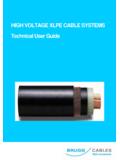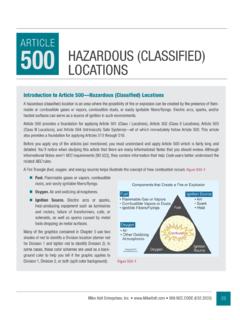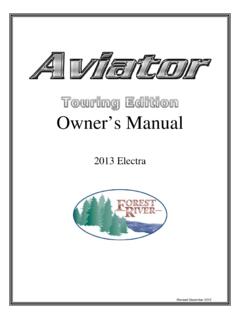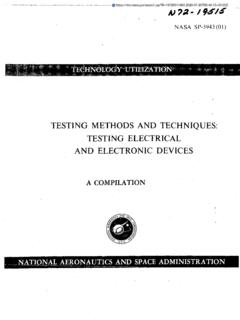Transcription of Electrical Power Generation in Aircraft: review ...
1 Electrical Power Generation in Aircraft: review , challenges and opportunities V. Madonna, Student Member, IEEE, P. Giangrande, and M. Galea., Member, IEEE. PDC Power Distribution Centre Abstract The constant growth of air traffic, the demand for PEC Power Electronics Converter performance optimization and the need for decreasing both PM Permanent Magnet operating and maintenance costs have encouraged the aircraft PMSM Permanent Magnet Synchronous Machine industry to move towards more electric solutions. As a result of SiC Silicon Carbide this trend, electric Power required on board of aircraft has SR Switched Reluctance significantly increased through the years, causing major changes SRM Switched Reluctance Machine in electric Power system architectures.
2 Considering this scenario, the paper gives a review about the evolution of electric Power TRU Transformer Rectifier Unit Generation systems in aircraft. The major achievements are VFG Variable Frequency Generator highlighted and the rationale behind some significant VS Variable Speed developments discussed. After a brief historical overview of the VSCF Variable Speed Constant Frequency early DC generators (both wind- and engine-driven), the reasons which brought the definitive passage to the AC Generation , for I. INTRODUCTION. larger aircraft, are presented and explained. Several AC.
3 Generation systems are investigated with particular attention being focused on the voltage levels and the generator technology. Further, examples of commercial aircraft implementing AC. S ECONDARY Power systems allow for aircraft safe operation and ensure passengers' comfort. For conventional aircraft, secondary Power systems combine pneumatic, Generation systems are provided. Finally, the trends towards hydraulic, mechanical and electric Power and their energy modern Generation systems are also considered giving prominence consumption represents approximately 5% of the total fuel to their challenges and feasibility.
4 Burnt during the flight [1]. Index Terms MEA, AEA, Aircraft Electric Power With the advent of the more electric aircraft (MEA) initiative, Generation , HEP, HVDC electric Power systems are progressively taking the place of pneumatic, hydraulic and mechanical Power systems [2-4]. Over time, this trend has led to an increase of required electric NOMENCLATURE. Power , particularly for larger aircraft [5-7], as shown in Fig. 1. AEA All Electric Aircraft For instance in the B787, several loads, which were APU Auxiliary Power Unit traditionally supplied by pneumatic bleed system, are now ATRU Autotransformer Rectifier Unit electrically-driven [8].
5 These loads include (but are not limited ATU Autotransformer Unit to) wing ice protection, environmental control system (ECS). CF Constant Frequency and the engine starting system [9]. Therefore, an important CSD Constant Speed Drive player in all of this is the need of on-board Electrical Power ECS Environmental Control System Generation . In Fig. 2, a general system-level scheme, regarding GCU Generator Control Unit the historical evolution of on-board Electrical Power Generation HP High Pressure HVDC High Voltage DC and distribution, is reported [1, 7]. IM Induction Machine The electric Power demand on-board of aircraft begun with IDG Integrated Drive Generator the requirement of starting the main engines.
6 Hence, Power LP Low Pressure Generation on aircraft dates back to the First World War period MEA More Electric Aircraft (1914-18), when the starting capability and also wireless n Rotational speed of the generator shaft [rpm] telegraphy were introduced on-board of military aircraft [10]. N1 Rotational speed of the low pressure spool [rpm] At the time, wind-driven generators were generally preferred to N2 Rotational speed of the high pressure spool [rpm] batteries, mainly due to their better reliability and the poor p Number of poles pair of the main generator energy density of the available batteries in the period.
7 Between This work is funded by the INNOVATIVE doctoral programme. The Nottingham, Nottingham, NG72RD, UK (1 2. INNOVATIVE programme is partially funded by the Marie Curie Initial 3 Training Networks (ITN) action (project number 665468) and partially by the Michael Galea is also with the School of Aerospace, University of Institute for Aerospace Technology (IAT) at the University of Nottingham. Nottingham Ningbo China, Ningbo 315100, China Vincenzo Madonna1, Paolo Giangrande2, and Michael Galea3 are all with the Power Electronics, Machines and Control (PEMC) group, University of the two world wars, electric services, such as lighting, V-Bombers were decommissioned, however, their Power signalling and heating, were brought into use [3, 11, 12] and Generation system is still in service today on the VC-10.)
8 With them the Power generated by the wind-driven generators air-to-air refuelling tankers. Generating AC voltage at constant escalated from 250W up to 1000W. Higher Power ratings were frequency required a coupling mechanical gearbox between the achieved by increasing the generated voltage levels. Indeed, the variable-speed prime mover ( engine shaft) and the generator 6 Vdc system (already in use in the automotive industry) was [16]. This complex hydromechanical unit introduced reliability soon replaced by the 12 Vdc system, which had been upgraded issues, due to increased component count (with several moving to the 28 Vdc system by 1936 [13].)
9 Parts), which needed frequent maintenance [17]. In the early 1990s, the need for more energy-efficient aircraft promoted the MEA concept, which was already known since 1940s. As a result of this trend, commercial aircraft implementing more- electric features are nowadays available and some examples are the A380 and the B787 [3]. Starting from the dawn of aviation, this paper presents a survey on the evolution of Electrical Power generators for aerospace applications. In particular, DC Power Generation is discussed in Section II, where the technologies implemented pre- and post- World Wars are examined.
10 In Section III, the AC. Power Generation technologies, such as constant frequency (CF) and variable speed constant frequency (VSCF) systems, are described and their main advantages and drawbacks are highlighted. Section IV deals with unconventional systems , such as switched reluctance machine (SRM) based systems, for Fig. 1. Evolution of Electrical Power need (in grey short to medium range generating electric Power on-board of military aircraft. Recent aircraft and in black medium to long range aircraft). achievements and today's Generation systems employed in MEA are considered in Section V.







